At the Munich Security Conference, NATO Secretary General Mark Rutte directed a pointed message to European nations: rather than lament about the constraints of the current alliance dynamics, member states should engage in constructive dialogue and proffer real solutions. His remarks reflect a deeper narrative of shifting priorities within NATO, particularly in light of the United States taking a more confrontational stance. Rutte’s insistence that European allies must stymie their grievances and instead brainstorm actionable ideas underscores the urgent need for a collaborative approach to security.
This unique plea demonstrates Rutte’s perspective on unity within NATO; rather than merely voicing dissatisfaction, countries are urged to engage meaningfully in discussions to enhance defense strategies. The Secretary General’s remarks have ignited a debate on how European members can collectively elevate their defense spending beyond previously established benchmarks.
As NATO looks ahead to its upcoming summit in The Hague, a pivotal shift seems on the horizon regarding defense expenditure targets. Rutte hinted at ambitious new goals, stating that the 2% GDP threshold set in 2014 would be surpassed, with possible figures exceeding 3%. This specific numerical commitment, while still somewhat ambiguous, signals a growing recognition among NATO allies that increased financial burden-sharing may become essential in response to geopolitical pressures, particularly from Russia.
This call for higher spending aligns with broader shifts in military consensus across member nations, where a fortified defense posture is increasingly seen as a necessity. Rutte’s statements echo the sentiments of U.S. Senator Lindsey Graham, who articulated that Russian aggression, particularly in Ukraine, has inadvertently accelerated NATO members’ military budgeting. The realization that threats are evolving has prompted a reevaluation of priorities and a push toward collective fortification.
Controversial discussions about NATO spending have become increasingly prevalent, especially with the anticipated return of former President Donald Trump to the political arena. During his initial term, Trump’s contentious relationship with NATO raised alarms over member states’ funding responsibilities. His criticisms targeted nations that failed to meet the 2% GDP defense target, emphasizing a perception that many European allies were heavily reliant on U.S. military support.
Trump’s assertion that NATO should pursue a target as high as 5% reflects a significant departure from traditional military budgeting discussions and presents a polarized viewpoint within the alliance. As European nations grapple with these assertions amid a changing geopolitical landscape, they must reconcile internal disagreements while enhancing defense commitments.
The current moment for NATO is characterized by an urgent need for cohesion, even as the pressures of increasing defense spending mount. The complexities of varying national interests within the alliance often lead to divergent views on funding and resource allocation. While the push towards unification is apparent, the practicality of achieving consensus on financial targets remains a significant challenge.
In the backdrop of these discussions, the landscape of defense spending has already evolved dramatically since Trump’s era. The latest reports suggest that in 2024, up to 23 NATO members are expected to meet the 2% GDP target—an increase from just six in 2018. However, the 5% target remains an ambitious and controversial aspiration. This rising trend places pressure on all allies to contribute significantly to collective defense efforts.
Historically, NATO has navigated many turbulent waters, adapting to the ever-changing security environment. The alliance’s recent discussions indicate a pivotal juncture; increasing threats from state and non-state actors alike necessitate bold, decisive actions by all members. Secretary General Rutte’s call is both a challenge and an invitation to prioritize solutions that reinforce NATO’s foundational principles of solidarity and mutual defense.
Ultimately, the road ahead for NATO will require not only higher financial commitments but also a willingness to engage deeply in collaborative security discourse. As member nations prepare for the summit in June, tangible commitments will be critical not just for bolstering budgets, but for fortifying the transatlantic bond that has historically distinguished NATO as a formidable collective defense organization. The future of NATO hinges upon its ability to respond not only with financial resolve but also with a renewed spirit of cooperation and unity.


Leave a Reply